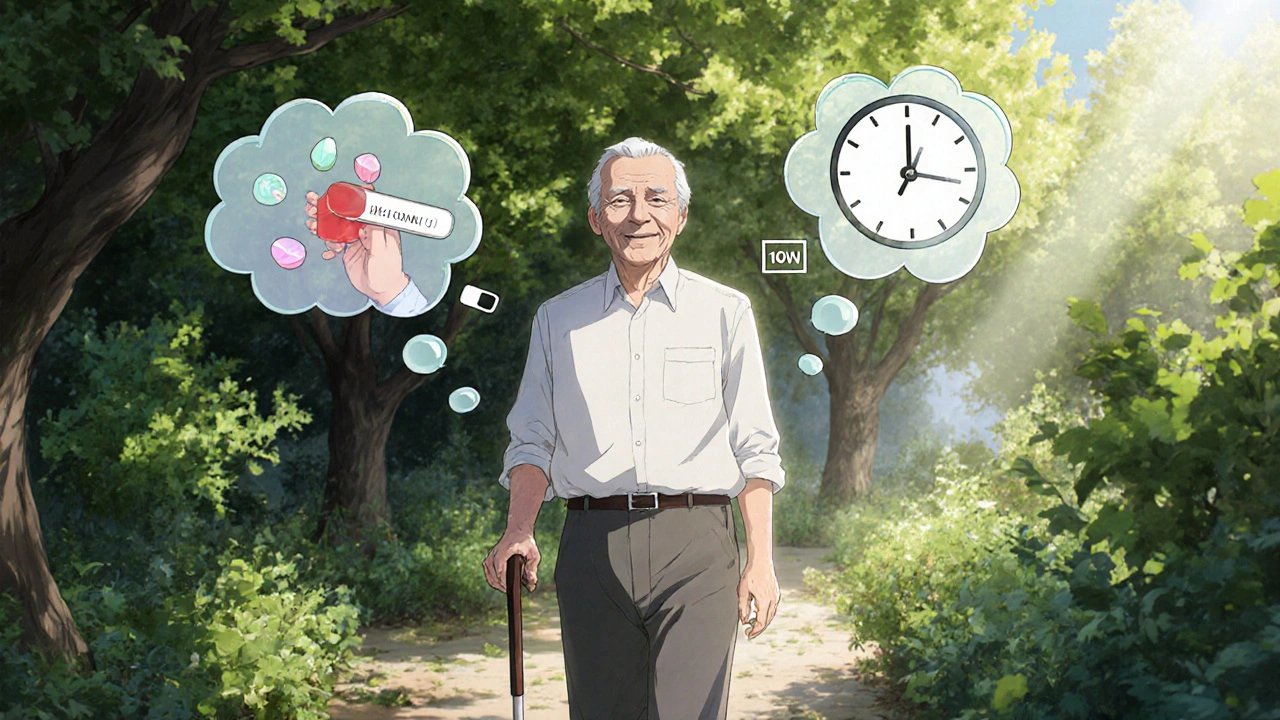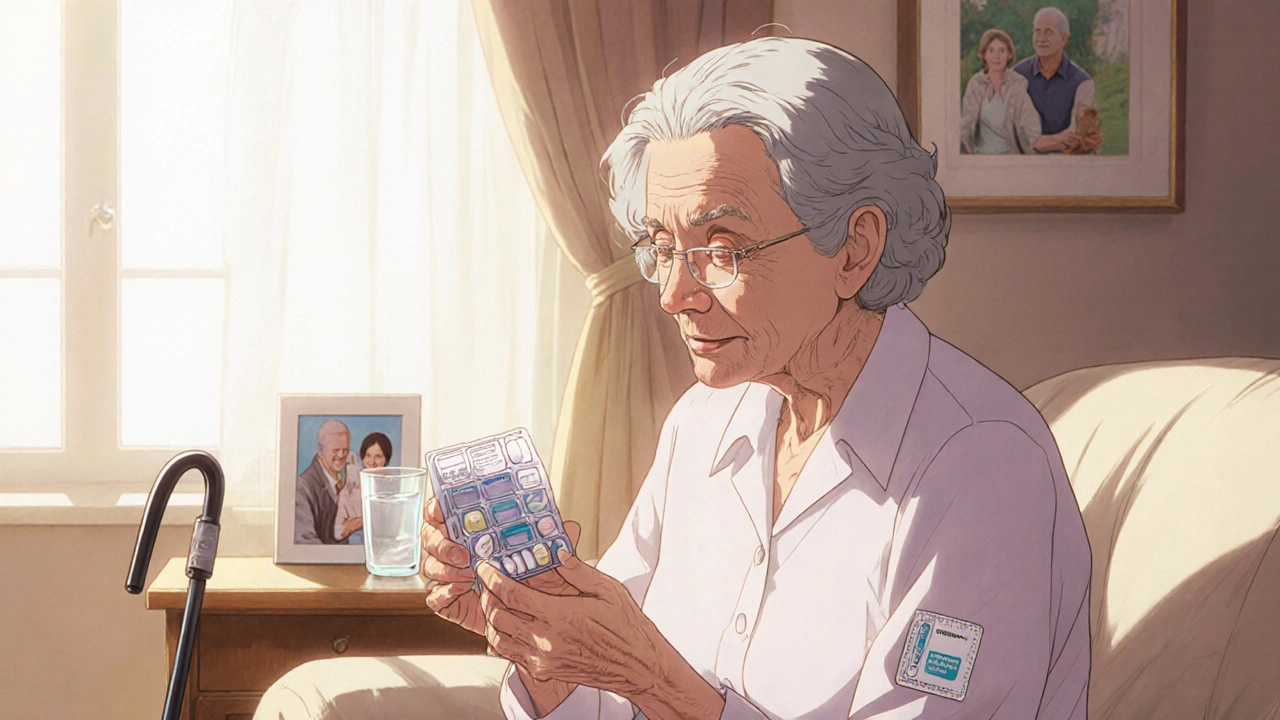Opioids for Seniors: Safe Pain Management and Essential Monitoring Tips
Many seniors live with chronic pain from arthritis, nerve damage, or past injuries. For some, opioids are necessary. But giving opioids to older adults isn’t like giving them to younger people. Their bodies process drugs differently. They often take multiple medications. And the risks-falls, confusion, breathing problems-can be life-threatening.
The good news? Opioids can still be used safely in seniors, but only with careful planning, lower doses, and close monitoring. The outdated idea that all opioids are dangerous for older adults has led to undertreated pain. The updated 2022 CDC guidelines now clearly state: opioids remain the first-line treatment for moderate-to-severe cancer pain in seniors, and rigid dose limits from earlier years caused more harm than good.
Why Seniors Need Special Opioid Rules
As we age, our bodies change. The liver and kidneys don’t clear drugs as quickly. Body fat increases, while muscle and water decrease. This means opioids stay in the system longer. A standard adult dose might be too strong, leading to drowsiness, confusion, or even respiratory depression.
Seniors are also more likely to be on other medications-blood thinners, antidepressants, heart pills. These can interact dangerously with opioids. For example, combining tramadol with an SSRI can trigger serotonin syndrome, a rare but serious condition. Or taking NSAIDs for too long can cause stomach bleeds or kidney damage, especially in frail seniors.
One study in JAMA Network Open (2023) found that after the 2016 CDC guidelines were misapplied, many doctors stopped prescribing opioids to seniors with cancer and switched them to gabapentinoids. But those drugs aren’t much better-they cause dizziness and confusion, which increases fall risk. The result? Seniors were left in pain, with no real improvement in safety.
What Opioids Are Safe for Seniors?
Not all opioids are created equal for older adults. Some should be avoided entirely. Others can be used safely if dosed correctly.
- Avoid: Meperidine (Demerol) and codeine. Meperidine builds up toxic metabolites that cause seizures and delirium. Codeine turns into morphine unpredictably in the body, making dosing unreliable.
- Use with caution: Tramadol and tapentadol. Both carry a risk of serotonin syndrome when mixed with other antidepressants. They’re not more effective than other opioids, but they come with extra risks.
- Preferred options: Oxycodone, morphine, hydromorphone, and buprenorphine. These are predictable, well-studied, and can be started at low doses.
Transdermal buprenorphine (a patch) is especially promising. A 2024 study in the ACOFP Journal found it causes less constipation and no central nervous system side effects-even when combined with low-dose oxycodone for breakthrough pain. That’s rare. Most opioids make seniors sleepy or foggy. Buprenorphine doesn’t, which makes it a top choice for long-term use.
How to Start Opioids Safely in Seniors
If opioids are needed, start low and go slow. That’s not just advice-it’s a medical standard.
For opioid-naïve seniors (those who haven’t taken opioids before), begin with 30-50% of the standard adult dose. That means:
- 2.5 mg of oxycodone (not 5 mg)
- 7.5 mg of morphine (not 15 mg)
Never start with long-acting or patch forms like fentanyl or extended-release oxycodone. These are for patients who already tolerate opioids. Giving them to someone new to opioids can cause fatal overdose.
Use liquid forms if possible. Pills often come in 5 mg or 10 mg increments. A 2.5 mg dose might mean splitting a pill-which is messy and inaccurate. Liquid formulations allow precise dosing down to 0.5 mg increments.
Also, avoid combining opioids with acetaminophen (Tylenol). Many combo pills like oxycodone/acetaminophen exist. But seniors should never take more than 2 grams of acetaminophen per day-especially if they’re over 80, drink alcohol, or have liver issues. That’s half the usual limit. Too much can cause sudden liver failure.
Monitoring: What to Watch For
Starting opioids is just the beginning. Monitoring is where safety happens.
Doctors should check in every 1-2 weeks after starting, then monthly. Look for:
- Respiratory rate: Is it below 12 breaths per minute? That’s a red flag.
- Cognitive changes: Is the patient more confused, forgetful, or disoriented? Delirium is common and dangerous.
- Fall risk: Are they stumbling? Are they using a cane more than before? Opioids slow reaction time.
- Constipation: This is almost universal. Prevent it with stool softeners and fluids-not just laxatives.
- Pain and function: Is their pain improving? Are they walking more? Sleeping better? Or are they just sedated?
Don’t rely on pain scales alone. A senior might say their pain is “5 out of 10,” but if they’re still staying in bed, the treatment isn’t working. The goal isn’t just less pain-it’s more function.
Urine drug screens are recommended for anyone on opioids longer than three months. This isn’t about suspicion-it’s about safety. It checks for unintended drug interactions or hidden substances like benzodiazepines, which can be deadly with opioids.
Non-Opioid Options That Actually Work
Opioids aren’t the only tool. And they shouldn’t be the first.
For arthritis or joint pain, topical NSAIDs (like diclofenac gel) are safer than pills. They don’t flood the body with drugs. Physical therapy helps too-strengthening muscles around a painful joint reduces pressure and pain.
For nerve pain (like diabetic neuropathy), gabapentinoids are sometimes used. But studies show they only reduce pain by about 1 point on a 10-point scale-barely better than placebo. And they cause dizziness. For many seniors, the trade-off isn’t worth it.
Consider non-drug options: acupuncture, cognitive behavioral therapy for pain, or even gentle yoga. These don’t fix the source of pain, but they help the brain cope with it. That’s powerful.
And for cancer-related pain? Opioids are still the gold standard. The American Society of Clinical Oncology and National Comprehensive Cancer Network both say so. Avoiding them out of fear is what’s dangerous.

What’s Changing in 2025?
Guidelines are shifting from numbers to people.
The old rule-“never exceed 90 MME per day”-is being replaced by functional goals. Is the patient able to get out of bed? Eat meals? Spend time with family? That matters more than a pill count.
Doctors are also starting to use pharmacogenetic testing. Some people metabolize opioids too slowly. Others break them down too fast. Genetic tests can help pick the right drug and dose before starting. It’s not common yet-but it’s coming.
And more clinics are offering pain management teams: doctors, pharmacists, physical therapists, and social workers all working together. Seniors don’t need one pill. They need a plan.
Bottom Line: Safety First, Pain Second
Opioids can help seniors live better. But they’re not harmless. The key is balance: enough to relieve pain, not so much that it causes harm.
Start low. Go slow. Monitor closely. Avoid risky drugs. Use non-opioid options first. And always ask: Is this helping them live, or just keeping them quiet?
There’s no perfect opioid for every senior. But with the right approach, pain can be managed without putting life at risk.
Can seniors take opioids for long-term pain like arthritis?
Yes, but only if other treatments haven’t worked. Start with low-dose oxycodone or buprenorphine patches. Avoid long-acting pills at first. Monitor for confusion, falls, and constipation. Regular check-ins every month are essential. Many seniors can use opioids safely for years if dosed properly and watched closely.
Why is buprenorphine better for seniors than other opioids?
Buprenorphine is a partial opioid agonist, meaning it doesn’t fully activate the brain’s opioid receptors. This lowers the risk of overdose, respiratory depression, and severe sedation. It also causes less constipation than morphine or oxycodone. Studies show it doesn’t cause cognitive side effects even when combined with low-dose oxycodone for breakthrough pain-making it one of the safest long-term options for older adults.
Is it safe to split opioid pills for seniors?
It’s better to avoid splitting pills. Many are designed to release slowly, and splitting them can cause dangerous spikes in drug levels. Instead, ask for liquid formulations or low-dose tablets. Pharmacists can often compound custom doses. A 2.5 mg oxycodone liquid is safer and more accurate than splitting a 5 mg tablet.
What should I do if my senior parent seems confused after starting opioids?
Call the doctor right away. Confusion could be opioid-induced delirium, especially if they’re on a high dose or new to opioids. Don’t stop the medication suddenly-this can cause withdrawal. Instead, ask for a dose reduction and a review of all other medications. Sometimes removing just one drug (like a sleep aid or anticholinergic) clears up the confusion.
Are there any opioid alternatives that are safer for seniors with kidney problems?
Yes. Morphine and hydromorphone can build up in kidney failure. Oxycodone and buprenorphine are safer because they’re cleared mostly by the liver. Buprenorphine is often the best choice for seniors with reduced kidney function. Always check creatinine levels before starting opioids and adjust doses based on kidney health.
How often should a senior on opioids have blood tests or urine screens?
Urine drug screens are recommended every 3-6 months for anyone on long-term opioids. Blood tests aren’t routine unless there’s concern about liver or kidney function. The main monitoring is clinical: checking pain levels, function, side effects, and mental status at every visit. Lab tests support the picture, but they don’t replace talking to the patient.
Next Steps for Families and Caregivers
If your loved one is on opioids:
- Keep a written log: What dose? When? Any side effects? Changes in walking or thinking?
- Ask the doctor: “Is this helping them do things they care about?” Not just “Is the pain gone?”
- Never let them take someone else’s pain pills-even if it’s the same drug.
- Store opioids locked up. Even one pill can be dangerous to a child or grandchild.
- Know the signs of overdose: slow breathing, unresponsiveness, blue lips. Have naloxone on hand if prescribed.
Pain is real. Fear of opioids shouldn’t silence it. With the right plan, seniors can live with less pain-and more dignity.


Daniel McKnight
November 26, 2025 AT 05:09I’ve seen too many grandpas on oxycodone nodding off at the dinner table like they’re in a hammock. But I’ve also seen my aunt finally walk to the garden again after switching to a buprenorphine patch-no fog, no falls, just quiet relief. It’s not about fear. It’s about finesse. Start low, watch close, and ditch the myth that all opioids are poison for seniors. Some are just… quieter weapons.